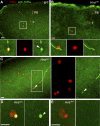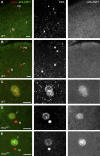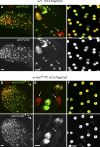The essential role of Drosophila HIRA for de novo assembly of paternal chromatin at fertilization
- PMID: 17967064
- PMCID: PMC2041997
- DOI: 10.1371/journal.pgen.0030182
The essential role of Drosophila HIRA for de novo assembly of paternal chromatin at fertilization
Abstract
In many animal species, the sperm DNA is packaged with male germ line--specific chromosomal proteins, including protamines. At fertilization, these non-histone proteins are removed from the decondensing sperm nucleus and replaced with maternally provided histones to form the DNA replication competent male pronucleus. By studying a point mutant allele of the Drosophila Hira gene, we previously showed that HIRA, a conserved replication-independent chromatin assembly factor, was essential for the assembly of paternal chromatin at fertilization. HIRA permits the specific assembly of nucleosomes containing the histone H3.3 variant on the decondensing male pronucleus. We report here the analysis of a new mutant allele of Drosophila Hira that was generated by homologous recombination. Surprisingly, phenotypic analysis of this loss of function allele revealed that the only essential function of HIRA is the assembly of paternal chromatin during male pronucleus formation. This HIRA-dependent assembly of H3.3 nucleosomes on paternal DNA does not require the histone chaperone ASF1. Moreover, analysis of this mutant established that protamines are correctly removed at fertilization in the absence of HIRA, thus demonstrating that protamine removal and histone deposition are two functionally distinct processes. Finally, we showed that H3.3 deposition is apparently not affected in Hira mutant embryos and adults, suggesting that different chromatin assembly machineries could deposit this histone variant.
Conflict of interest statement
Competing interests. The authors have declared that no competing interests exist.
Figures










Similar articles
-
ASF1 is required to load histones on the HIRA complex in preparation of paternal chromatin assembly at fertilization.Epigenetics Chromatin. 2018 May 11;11(1):19. doi: 10.1186/s13072-018-0189-x. Epigenetics Chromatin. 2018. PMID: 29751847 Free PMC article.
-
Drosophila Yemanuclein and HIRA cooperate for de novo assembly of H3.3-containing nucleosomes in the male pronucleus.PLoS Genet. 2013;9(2):e1003285. doi: 10.1371/journal.pgen.1003285. Epub 2013 Feb 7. PLoS Genet. 2013. PMID: 23408912 Free PMC article.
-
The histone H3.3 chaperone HIRA is essential for chromatin assembly in the male pronucleus.Nature. 2005 Oct 27;437(7063):1386-90. doi: 10.1038/nature04059. Nature. 2005. PMID: 16251970
-
A Molecular Prospective for HIRA Complex Assembly and H3.3-Specific Histone Chaperone Function.J Mol Biol. 2017 Jun 30;429(13):1924-1933. doi: 10.1016/j.jmb.2016.11.010. Epub 2016 Nov 19. J Mol Biol. 2017. PMID: 27871933 Free PMC article. Review.
-
Histone chaperones: 30 years from isolation to elucidation of the mechanisms of nucleosome assembly and disassembly.Cell Mol Life Sci. 2008 Feb;65(3):414-44. doi: 10.1007/s00018-007-7305-6. Cell Mol Life Sci. 2008. PMID: 17955179 Free PMC article. Review.
Cited by
-
The intimate genetics of Drosophila fertilization.Open Biol. 2015 Aug;5(8):150076. doi: 10.1098/rsob.150076. Open Biol. 2015. PMID: 26246493 Free PMC article. Review.
-
Nucleosome-depleted chromatin gaps recruit assembly factors for the H3.3 histone variant.Proc Natl Acad Sci U S A. 2012 Nov 27;109(48):19721-6. doi: 10.1073/pnas.1206629109. Epub 2012 Nov 12. Proc Natl Acad Sci U S A. 2012. PMID: 23150573 Free PMC article.
-
A histone chaperone, DEK, transcriptionally coactivates a nuclear receptor.Genes Dev. 2010 Jan 15;24(2):159-70. doi: 10.1101/gad.1857410. Epub 2009 Dec 29. Genes Dev. 2010. PMID: 20040570 Free PMC article.
-
ASF1 is required to load histones on the HIRA complex in preparation of paternal chromatin assembly at fertilization.Epigenetics Chromatin. 2018 May 11;11(1):19. doi: 10.1186/s13072-018-0189-x. Epigenetics Chromatin. 2018. PMID: 29751847 Free PMC article.
-
Wolbachia-induced cytoplasmic incompatibility is associated with decreased Hira expression in male Drosophila.PLoS One. 2011 Apr 29;6(4):e19512. doi: 10.1371/journal.pone.0019512. PLoS One. 2011. PMID: 21559343 Free PMC article.
References
-
- Polo SE, Almouzni G. Chromatin assembly: a basic recipe with various flavours. Curr Opin Genet Dev. 2006;16(2):104–111. - PubMed
-
- Akey CW, Luger K. Histone chaperones and nucleosome assembly. Curr Opin Struct Biol. 2003;13(1):6–14. - PubMed
-
- Poccia D, Collas P. Transforming sperm nuclei into male pronuclei in vivo and in vitro. Curr Top Dev Biol. 1996;34:25–88. - PubMed
-
- Wright SJ. Sperm nuclear activation during fertilization. Curr Top Dev Biol. 1999;46:133–178. - PubMed
Publication types
MeSH terms
Substances
LinkOut - more resources
Full Text Sources
Molecular Biology Databases
Miscellaneous

